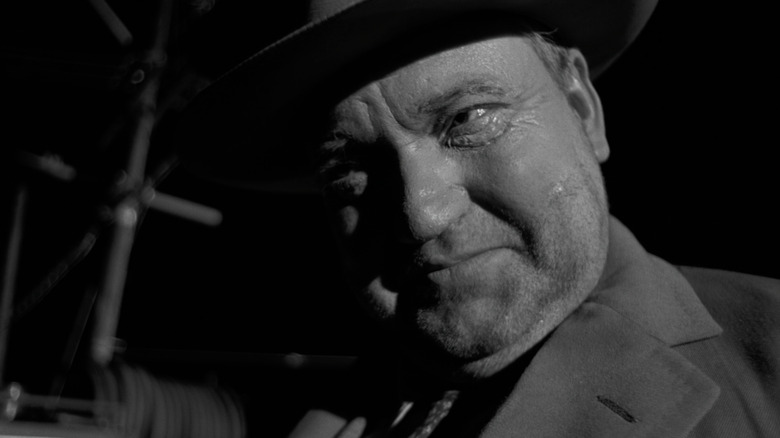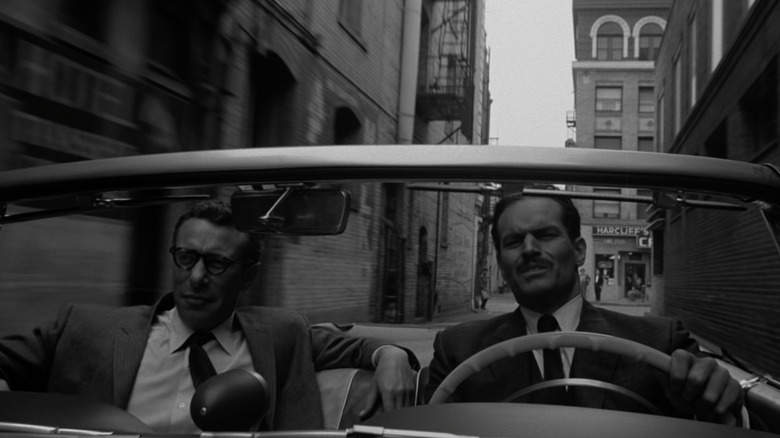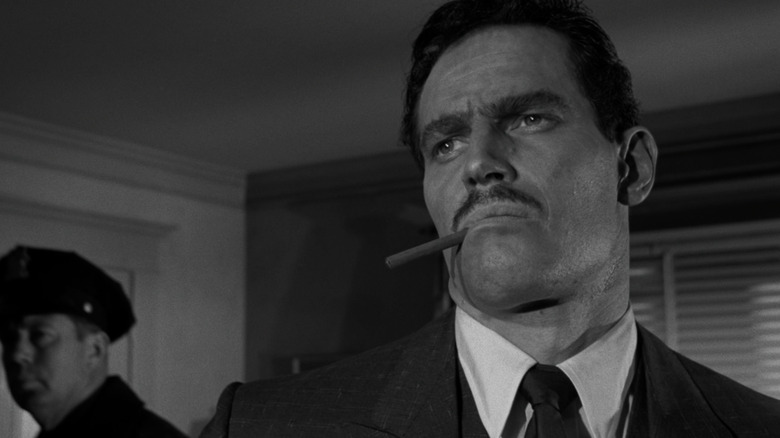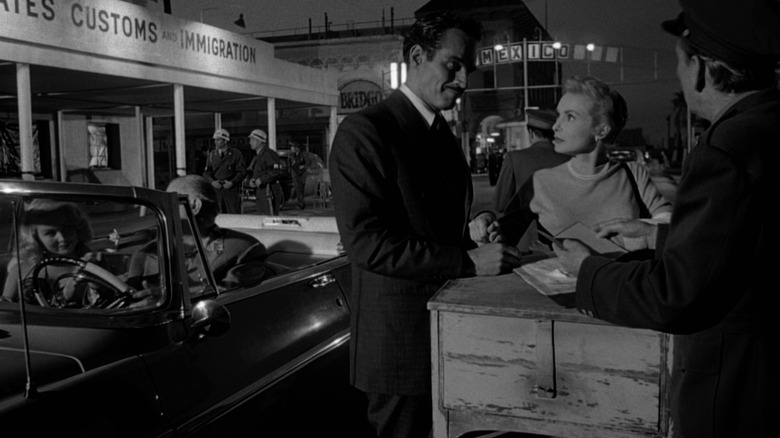How Orson Welles Filmed The Impossible For Touch Of Evil
Orson Welles was always trying new things. One might think that in earning complete creative control for his debut feature film "Citizen Kane" when he was still in his mid-20s, he could easily rest on his laurels. If he already knew best, what more was there to learn? But that was not Welles. Once he completed a project, he wanted to push himself further and figure out new, interesting ways to create stories on the big screen. This constant innovation and reinvention of his style is what makes him one of the most revered filmmakers of all time.
Of course, Hollywood typically does not like giving creative control away to people who like to experiment or take risks. After all, the film industry is a business first and foremost, and that collision of oil and water always made it hard for Welles to be able to firmly plant his feet inside the system. Nearly every film he made after "Citizen Kane" was a struggle. He would try something bold, the studios would come in and fight back (usually by recutting and reshooting his films without approval), and he would have to sit to the side for a bit, licking his wounds before trying to make his way back in. Eventually, he abandoned Hollywood altogether and started making movies over in Europe, scraping together any dollar he could.
But even in the films that would endure so much studio interference, Welles still had the ability to create dazzling sequences and images that have influenced many directors working today. One such of these dynamic innovations might not seem obvious to a modern-day viewer. Welles implemented a filmmaking technique in his 1958 noir masterpiece "Touch of Evil" that would become fairly common practice in movie making from then on out. And, no, I am not talking about the elaborate long take that begins the film. This one is much smaller and, perhaps, even more important.
Ditching rear screen projection
So many movies feature scenes where people drive cars and for decades, there was a commonplace technique for filming such a moment. The actors would be in a rigged-up car on a set with a screen on which previously shot footage of traffic and roads would be projected in the background. The actors would then mime driving along with the rear screen projection footage. It never looked real, but it was just an imagined reality everyone accepted. If we saw footage of cars driving in a location, that would be done by stunt drivers, with the faces of the people driving obscured.
Orson Welles used this tried and true method in "Touch of Evil," but for one scene, he wanted to try something different. He wanted a shot of Charlton Heston actually driving the car, using the same camera angle they would use for a shot on rear screen projection. Heston recalls in his autobiography "In the Arena":
"Orson decided to shoot it in a real car, driving down a real alley. Nowadays, of course, that's a piece of cake. The film's faster, the lights are half the size, so are the mikes and cables. When Orson's cameraman had the shot rigged, the back of the car was crammed with batteries and the recording unit, with cables twisting around the seats to mikes taped on the dashboard, and the camera was strapped to a wooden platform on the hood, with no room for even the camera operator and the sound mixer. Someone suggested cutting the front off the car and towing the rear half behind a truck large enough to carry a crew. Orson snorted. 'Nonsense! These boys can shoot it without a crew.'"
The shot only lasts for 40 seconds, but it is arresting to watch. They are cruising at a pretty fast speed, and just seeing how the wind blows their hair and suit jackets gives a kind of thrill rarely seen in a fairly mundane driving scene. Also, we get a real sense of the three-dimensional space. Simply seeing the buildings pass them as they drive adds a whole new level of reality to the moment. And this is not a car on a trailer being pulled by another car. Heston is actually driving this thing.
Charlton Heston the camera operator
Deciding to shoot this way also creates another major problem: Who is there to operate the camera and sound equipment? You obviously aren't going to have the cinematographer or a camera operator hanging off the front of the car. Well, because it was just Charlton Heston and actor Mort Mills in the car together, they also had to operate all the equipment as well. Heston continues:
"With a crash course in switching on both camera and sound, I drove down the alley half a mile to our start mark and said, 'Turn over.' Mort Mills, my partner in the scene, flipped the right switches, checked the appropriate dials and said, 'Speed.' (Technical note: Nobody ever says 'Lights, camera, action!' on a movie set.) I gunned the car and yelled, 'Action!' as we tore off, acting away. We had a marvelous time."
Welles also had to rely on those two actors to determine if any given take was worth using. There was no video village or playback. He would not get to see what was shot until dailies at a later time.
Now, mounting a camera on a car out on location does not seem nearly as special today, but back then, it was completely innovative. Studios were scared about possibly risking the safety of actors when shooting a driving scene, and the use of trailers became much more commonplace. Strangely enough, we have been reverting back to the rear screen projection model as of late, using a green or blue screen to add in images later rather than live projection. Welles had it right in 1958, though. The driving needs to feel real. It's like when someone holds an empty coffee cup and pretends that it has liquid in it. We can usually tell.
That opening shot, though
Look, I can't write a piece about "Touch of Evil" without shouting out the breathtaking three-and-a-half-minute opening tracking shot that follows Charlton Heston and Janet Leigh making their way across the Mexican border. It is obviously the most breathtaking technical filmmaking element of the movie, and one that required so much coordination and focus to pull off. Heston writes about the opening shot:
"It was technically an all but impossible shot, depending on precise timing, not only from Janet and me, the couple in the car and the passing extras, but most critically of all, from the boom grip (the man running the boom) and of course the camera operator. Today, a remote-controlled camera on the end of a Python boom would make the shot far easier to prepare and not nearly as hard to shoot. Then, it was a wonder ... We shot on it all night, with various things going wrong, most often the actor playing the IRS guard at the border crossing. He had only a line or two, but it must have been terrifying for him to see the whole company bearing down on him from a block away. When we'd get to him, he'd flub his lines. At last, as dawn began to lighten in the east, Orson said to him patiently, 'All right, let's do it once more. This time, if you aren't sure of your line, just move your lips-we can dub it in later. But whatever you do, please God don't say, "I'm sorry, Mr. Welles."' That's the take that's in the movie."
It is a feast for the eyes and perfectly executes every single story and character beat it needs to, and there is a reason it is the ultimate comparison point whenever a filmmaker tries to do an elaborate one-take sequence. "Touch of Evil" presents the gold standard. However, it could be argued that a lot of directors took the wrong lesson from this shot, trying long takes in their own films for the thrill of it rather than as a way to enhance the actual storytelling. That driving sequence actually ended up being the more practical teaching tool, as it has affected so many more films than we could ever know.



